Goodbye and Goodnight, Garland Jones
The demolition of the Garland Jones Office Building could likely be the most discussed urban planning event in the history of Raleigh. Just about every local blog has weighed in since the decision was made by Wake County to replace the office building with a new justice center. The discussion remained mostly online, in print, and in personal circles. Opposition and protest against demolition was largely absent from within the halls of county government. In the end, however, it probably wouldn’t have mattered. The decision likely would have been made regardless of any public outcry, large or small.
Well over a year over since the initial decision was made, and after several months of careful preparation and planning, the building began to slowly come crumbling down late Wednesday evening. The dust and debris created dense clouds over the area, and the sound of the heavy equipment reverberated off of the surrounding structures. The sights and sounds were quite dramatic. Raleigh was losing a landmark.
As an admirer of the Modernist style of architecture embodied in the Garland Jones Office Building, I was quite sad to see it come down. Despite the fact that Raleigh has one of the largest collections of buildings in this style, this was the last remaining example of “high modernism,” representing its most refined and embellished form.
By and large, the most thoughtful and intelligent essay on this particular building was expressed by Clearscapes architect Jon Zellweger at New Raleigh. His piece “Everything Comes At A Price – A Living Eulogy For The Garland Jones Office Building” was quoted and debated by several local media sources, including WUNC’s The State of Things, where he made a guest appearance to discuss the fate of the GJOB.
A few of the contributors to this blog reached out to friends within city government, in hopes they could put us in touch with county officials. The idea was that those in county government could ultimately connect us with the Superintendent of the project at Barnhill Contracting Company, so that we could get a tour of the building before it came down.
Luck was on our side, as the chain of communication happened far more quickly than we had expected. Within a week or two after making initial contacts to Greg Hallam and Dan Becker from the City of Raleigh, we were in touch with Ken Cass (above), the Superintendent of the project. We were lucky to have such a person give us the tour. He told us upon our first meeting that “I went to the top for you guys,” meaning he had cleared our visit with executives at the contracting company.
After filling out the necessary paperwork and donning safety gear, we were on our way to taking a look at the former office building’s last days.
This was the first (officially sanctioned) time I had been on a construction or demolition site, and it was certainly an exciting and interesting experience. Buildings are like the multitude of electronic devices we use every day: we don’t care how they work or why, we just care that they do. When you see a building being stripped down to the bare elements that hold it together, you get a good appreciation for what it is that makes it work.
Most of the remaining electronic and mechanical systems inside the GJOB dated back to 1960, its year of construction, when it was originally known as First Federal Savings and Loan.
Pictured above is the electric switching mechanism used by the elevator system. I won’t pretend to know how it works, but it was quite fascinating to watch. As the elevator descended or ascended to its destination, each of the mechanical switches would click off and on, making sounds as well as moving as it made contact. Contemporary elevator systems certainly do not have the tactile or auditory feedback as this system does. It was a living relic, reminiscent of when transistors ruled the day, long before the ubiquity of silicon computer chips.
The “time + temp” sign itself is a landmark. Other than perhaps the distinctively-patterned curtain walls, comprisied of panels in differing shades of blue, translucent glass, the clock was the most recognizable part of the Garland Jones Office Building. At the time of demolition, it still clung to the side of the structure, like a captain going down with his ship.
The beautiful white marble slabs that covered the corner and end walls of the structure were salvaged, although I can’t say what their final destination was. For the past several weeks, the building has consisted of internal i-beams and support structure, the curtain walls, and not much else.
Although construction of the new Justice Center that will serve as an extension to the Wake County Courthouse has been delayed by about a year, there’s no question that the project will get underway. Barnhill is in this for the long haul. This is a $200+ million dollar project not slated to be ready for another 5 or 6 years.
The once proud lobby of this former bank, with its matching sculpted ceiling and patterned terazzo floor, is no longer there — soon an empty surface lot will be all that remains of this fine example of mid-20th century architecture.
Despite my sadness over the loss of this architectural gem, I fully understand that a city, county, or state government will move forward with new construction to accommodate a growing population base. We can sit back and debate the merits of how, why, and when — but with every bit of new construction there will be those who lament the loss of the previous structure as well as those who welcome a new one.
It’s been the nature of human progress since the beginning of recorded history. When a building is obsolesced and metropolitan population grows, we build something bigger and more modern in its place. After all, Raleigh residents lamented the loss of the 19th century Academy of Music Building, the former occupant of the site on which First Federal erected their new flagship bank building in 1960.
All we can really do is to record the past with words and pictures, and grab architectural artifacts to keep as relics of an era past. Not all the iconic multi-colored glass panels are heading for the scrap heap, however. Around 20 to 30 panels still exist somewhere –Â in the living rooms and closets of several Raleigh residents. Pieces of this structure will live on, and serve some sort of purpose, however far removed from the original intent.


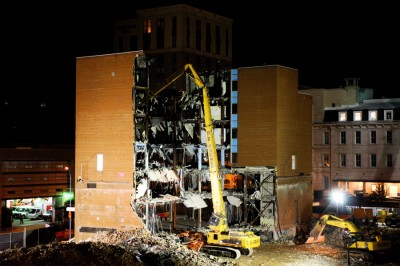
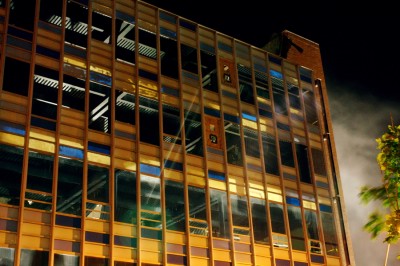
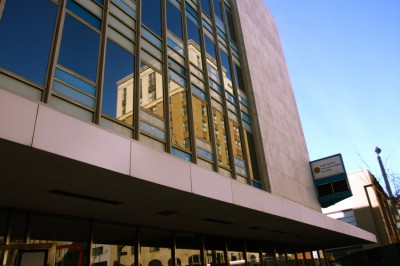

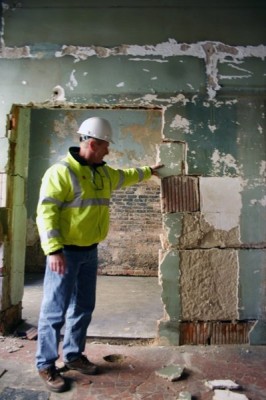
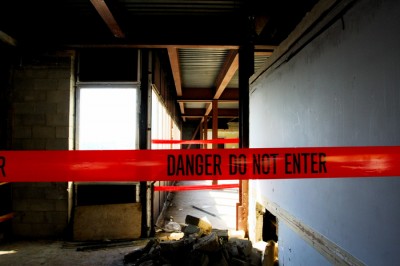
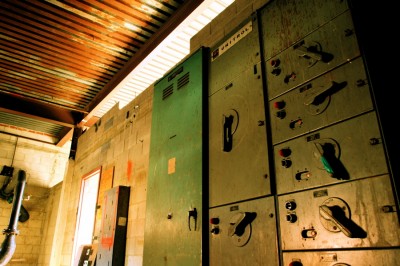


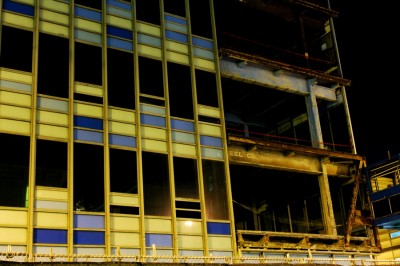

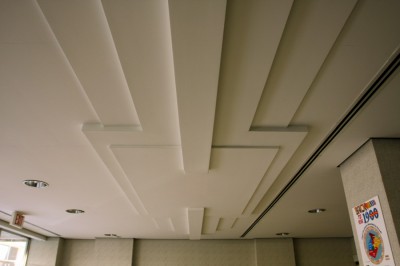
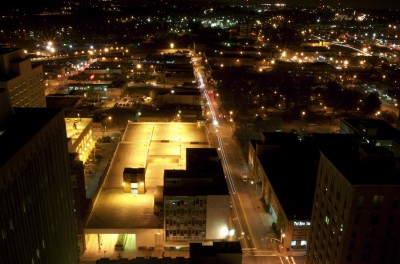
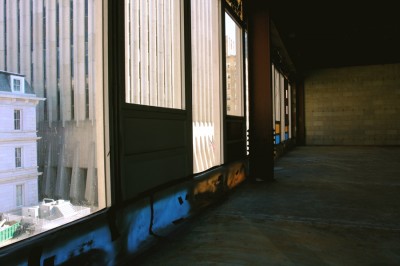
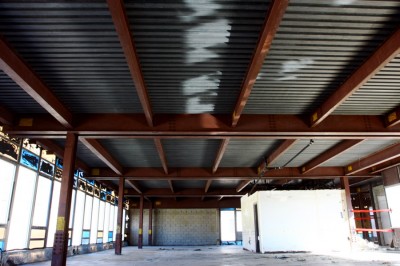
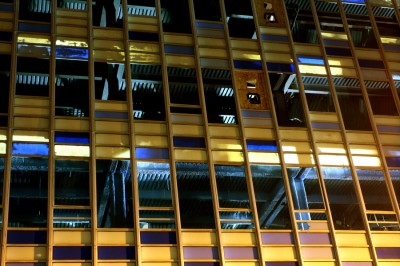
 Sign up for the Newsletter
Sign up for the Newsletter
04/30/2009
The latest in a long long long list of how Raleigh and the county have become victims of their own success.
In one of the pictures, I noticed the rear of that old federal building across the street. Let’s get rid of that old eyesore as well.
Thanks for a fine article and inside look.
04/30/2009
Really informative and well-written article, John. And the pictures you managed to take tell a really great narrative of the building.
04/30/2009
Another memory from my childhood gone to dust! Thank you for the inside look.
12/04/2009
This and the Lawyers Building will be missed.
07/13/2010
I worked in the Garland H. Jones building for 1 and a half years and though I am not a fan of that style of architecture I did appreciate it. I have a small piece of marble on my desk at my new office that was from the side of the building. It lay on the sidewalk during demolition. I thought that I had earned in since the elevators were not very kind to me during my stay. I did have a chance to rummage through the floors before our office was moved. I went on missions to scope out extra furniture that other offices had left behind. I saved a huge plant! I was able to check out most of the building which was very interesting especially after working there for almost 2 years and only seeing one floor. I was lucky to have gotten to see the building mostly vacant with out so much demo that it was not recognizable as office space. The basement was most impressive. I have a map that was left behind that is yellowed and floor plans of our old office space. I also took shots of the building in various stages of demolition.
07/28/2010
It didn’t have to be that way:
http://tinyurl.com/28bzrd3
10/18/2012
It’s been a long time since I’ve been to Raleigh but I was familiar with so many of the places described on this site. Was the NC Extension Agency located in the Garland Jones Building? For some reason it looks like the building I remember going to for 4-H activities.
09/24/2017
Great blog. Sometimes, when there was a teacher workday at Francis Lacy I’d go to work with my father, who’s attorney office was in the old BB&T building downtown (mid-rise, mid-century modern, black and steel building on Wilmington St. (still a bank, but different one). We’d go to lunch at either the old Belk’s cafeteria downtown or the Mecca, and we passed the Garland building at least once a day…to check out the time and temperature on the old sign out front. Even at a young age, I wasn’t crazy about the “look” of the Garland (never was a fan of Modernist), nor the ugly, brutalist monstrosity known as the “old courthouse.” But as I get older, and see lots of these Mid-Century Modern buildings being torn down all over my hometown, I do feel a bit sad to see them go.
07/28/2023
Electrical gear is Cutler Hammer Unitrol motor control center. Most likely controlled pumps and fans, the lungs and heart of the building.
07/29/2023
cwbh16